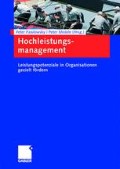Auszug
Der Beitrag thematisiert das Verhältnis von organisationalen Routinen und Hochleistungssystemen. Zwei der zentralen Merkmale von Hochleistungssystemen stellen die minutiöse Abstimmung und präzise Durchstrukturierung von Leistungsprozessen dar, sodass solche Systeme, ob nun auf Teambasis oder in größeren organisationalen Einheiten, in einem noch zu erörternden Sinne als routinisiert angesehen werden können. Beispiele für solche Systeme finden sich sowohl im Non-Profit-Bereich, wie etwa einem Sondereinsatzkommando der Polizei, als auch in unternehmerisch tätigen Einheiten, wie etwa einem Entwicklungsteam in der Industrie. Kennzeichnend ist dabei, dass Hochleistungssysteme immer wieder besonderen Anforderungen gegenüberstehen, die sich jedoch im Grunde einer rein routinemäßigen Abarbeitung entziehen. Im Folgenden wird deshalb der Überlegung nachzugehen sein, a) inwieweit Hochleistungssysteme routinebasiert sein dürfen und b) welche zusätzlichen Vorkehrungen solche Systeme treffen müssen, um die mit Routinierung einhergehenden „Nebenfolgen“ zu kompensieren oder zu vermeiden.
Access this chapter
Tax calculation will be finalised at checkout
Purchases are for personal use only
Preview
Unable to display preview. Download preview PDF.
Literatur
Becker, M., The Concept of Routines: Some Clarifications, in: Cambridge Journal of Economics Vol. 29(2), 2005, S. 249–262.
Cohen, M./ Bacdayan, P., Organizational Routines are Stored as Procedural Memory: Evidence from a LKboratory Study, in: Organization Science, Vol. 5(4), 1994, S. 554–568.
Collinson, S./ Wilson, D. C., Inertia in Japanese Organizations: Knowledge Management Routines and Failure to Innovate, in: Organization Studies, Vol. 27(9), 2006, S. 1359–1387.
Feldman, M. S./ Pentland, B., Reconceptualizing Organizational Routines as a Source of Flexibility and Change, in: Administrative Science Quarterly, Vol. 48(4), 2003, S. 94–118.
Feldman, M. S./ Rafaeli, A., Organizational Routines as Sources of Connections and Understandings, in: Journal of Management Studies, Vol. 39(3), 2002, S. 309–331.
Gilbert, C. G., Unbundling the Structure of Inertia: Resource versus Routine Rigidity, in: Academy of Management Journal, Vol. 48(5), 2005, S. 741–763.
Ivory, C./ Alderman, N., Can Project Management Learn anything from Studies of Failure in Complex Systems?, in: Project Management Journal, Vol.36(3), 2005, S. 5–16.
Luhmann, N., Lob der Routine, in: Verwaltungsarchiv, Jg. 55, 1964, S. 1–33.
March, J. G./ Simon, H. A., Organizations, New York et al. 1958.
Miller, D., The Icarus Paradox: How Exceptional Companies Bring about their Own Downfall, New York et al. 1990.
Miller, D., The Architecture of Simplicity, in: Academy of Management Review, Vol. 18(1), 1993, S. 116–138.
Mistele, P., Die Relevanz der High Reliability Theory für Hochleistungssysteme, FSA-prints 01–05. Chemnitz 2005.
Nelson, R. R./ Winter, S. G., An Evolutionary Theory of Economic Change. Cambridge/MA 1982.
Pawlowsky, P./ Mistele, P./ Geithner, S., Hochleistung unter Lebensgefahr, in: Harvard Business Manager, Jg. 27(11), 2005, S. 50–58.
Pentland, B. T./ Rueter, H., Organisational Routines as Grammars of Action, in: Administrative Sciences Quarterly Vol. 39(3), 1994, S. 484–510.
Perrow, C., Normal accidents: Living with High Risk Technologies, New York 1984.
Roberts, K. H., Managing High Reliability Organizations, in: California Management Review, Vol. 32(4), 1990a, S. 101–113.
Roberts, K. H., Some Characteristics of High Reliability Organizations, in: Organization Science, Vol. 1(2), 1990b, S. 160–177.
Roberts, K. H., Cultural Characteristics of Reliability enhancing Organizations, in: Journal of Managerial Issues, Vol. 5(2), 1993, S. 165–181.
Roberts, K. H./ Bea, R., Must Accidents happen? Lessons from High-Reliability Organizations, in: Academy of Management Executive, Vol. 15(3), 2001, S. 70–78.
Roberts, K. H./ Rousseau, D. M./ La Porte, T. R., The Culture of High Reliability: Quantitative and Qualitative Assessment aboard Nuclear-Powered Aircraft Carriers, in: Technology Management Research, Vol. 5(1), 1994, S. 141–161.
Rousseau, D. M., The Price of Success? Security-oriented Cultures and High Reliability Organizations, in: Industrial Crisis Quarterly, Vol. 3(4), 1989, S. 285–302.
Schein, E. H., What is Culture?, in: Frost, P. J./ Moore, L. F. (Hrsg.): Reframing Organizational Culture, Newbury Park, Ca. 1991, S. 243–253.
Schreyögg, G./ Sydow, J./ Koch, J., Organisatorische Pfade — Von der Pfadabhängigkeit zur Pfadkreation?, in: Managementforschung, Band 13, 2003, S. 257–294.
Schreyögg, G./ Koch, J./ Sydow, J., Routinen und Pfadabhängigkeit, in: Schreyögg, G./ Werder, A.v. (Hrsg.), Handwörterbuch Unternehmensführung und Organisation, 4. Aufl., Stuttgart 2004, S. 1296–1304.
Shalley, C. E./ Oldham, G. R./ Porac, J. F., Effects of Goal Difficulty, Goal-setting Method, and Expected External Evaluation on Intrinsic Motivation, in: Academy of Management Journal, Vol. 30, 1987, S. 553–562.
Taylor, F. W., Principles of Scientific Management, New York 1911.
Tripsas, M./ Gavetti, G., Capabilities, Cognition, and Inertia: Evidence from Digital Imaging., in: Strategic Management Journal, Vol. 21 (Special Issue (10/11)), 2000, S. 1147–1161.
Weick, K. E./ Sutcliff, K., M., Managing the Unexpected: Assuring High Performance in an Age of Complexity, San Francisco 2001.
Author information
Authors and Affiliations
Editor information
Editors and Affiliations
Rights and permissions
Copyright information
© 2008 Betriebswirtschaftlicher Verlag Dr. Th. Gabler | GWV Fachverlage GmbH, Wiesbaden
About this chapter
Cite this chapter
Koch, J. (2008). Routinen in Hochleistungssystemen — Zwischen Perfektionierung und Mindfulness. In: Pawlowsky, P., Mistele, P. (eds) Hochleistungsmanagement. Gabler. https://doi.org/10.1007/978-3-8349-9878-1_6
Download citation
DOI: https://doi.org/10.1007/978-3-8349-9878-1_6
Publisher Name: Gabler
Print ISBN: 978-3-8349-0709-7
Online ISBN: 978-3-8349-9878-1
eBook Packages: Business and Economics (German Language)

